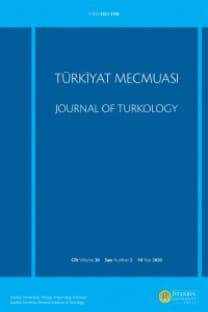Garib-nâme’de Aşk Metaforu
Bu çalışmanın amacı, George Lakoff ve Mark Johnson tarafından 1980 tarihinde kaleme alınan Metaphors We Live By adlı eserde ortaya konan çağdaş metafor teorisinden hareketle, Garib-nâme’nin Süleymaniye Laleli nüshasının ilk cildindeki aşk metaforlarını tespit etmektir. Garib-nâme’nin ilk cildindeki aşk metaforlarını tespit etmek için Pragglejaz Group’un geliştirdiği The Metaphor Identification Procedure (MIP) kullanılmıştır. Garib-nâme’nin ilk cildinde toplam 176 adet aşk metaforu tespit edilmiştir. Bunların içinde en çok kullanılan aşk metaforlarının sırayla AŞK CANLI BİR ORGANİZMADIR, AŞK BİR NESNEDİR, AŞK KAPTIR, AŞK ATEŞTİR, AŞK YOLDUR ve AŞK FİZİKSEL BİR GÜÇTÜR metaforları olduğu ortaya konmuştur. Mezkûr metaforlar içinde AŞK CANLI BİR ORGANİZMADIR metaforunun önemli bir yekûn tuttuğu görülmüş, bu metafor bağlamında da aşkın daha çok insan kavramı açısından ele alındığı tespit edilmiştir. Bu zaviyeden hareketle, Garib-nâme’nin ilk cildinde aşkla alakalı hâkim bakış açısının aşkı canlı bir organizma olarak ele almak olduğu ifade edilebilir. Yine, çalışma sonucunda, çağdaş metafor teorisinin Garibnâme özelinde Türkçenin tarihî devrelerinden biri olan Eski Anadolu Türkçesi devresi üzerinde de uygulanabileceği görülmüştür.
Anahtar Kelimeler:
Âşık Paşa, Garib-Nâme, Bilişsel Dil Bilimi, Bilişsel Anlam Bilimi, Çağdaş Metafor Teorisi
Love Metaphor in Garib-nâme
The aim of this study was to identify the love metaphors in the first volume of Garib-nâme’s Süleymaniye Laleli copy, based on the contemporary theory of metaphor presented in the work Metaphors We Live By written by George Lakoff and Mark Johnson in 1980. The Metaphor Identification Procedure (MIP) developed by the Pragglejaz Group was used to identify the love metaphors in the first volume of Garib-nâme. A total of 176 love metaphors were identified in the first volume of Garib-nâme. The results of the analysis demonstrated that the most frequently used metaphors of love were, respectively, LOVE IS A LIVING ORGANISM, LOVE IS AN OBJECT, LOVE IS CONTAINER, LOVE IS FIRE, LOVE IS WAY, and LOVE IS A PHYSICAL FORCE. It was discovered that the metaphor of LOVE IS A LIVING ORGANISM holds an important place among the mentioned metaphors, and it was discovered that love was mostly discussed in terms of the concept of humans in the context of this metaphor. According to this viewpoint, the dominant point of view regarding love in the first volume of Garib-nâme is to consider love as a living organism. Again, as a result of the study, it was seen that the contemporary theory of metaphor could also be applied to the Old Anatolian Turkish period, which was one of the historical periods of Turkish, through the example of Garib-nâme.
Keywords:
Âşık Pasha, Garib-Nâme, Cognitive Linguistics, Cognitive Semantics, Contemporary Theory Of Metaphor,
___
- Âşık Paşa. Garib-nâme: Tıpkıbasım Karşılaştırmalı Metin ve Aktarma. 4 cilt. Hazırlayan Kemal Yavuz. Ankara: TDK, 2000. google scholar
- Cebeci, Oğuz. Metafor ve Şiir Dilinin Yapısal Özellikleri. İstanbul: İthaki Yayınları, 2019. google scholar
- Çalışkan, Nihal. Kavramsal Anahtar Modeliyle İki Dilli Çocuklara Metafor ve Deyim Öğretimi. Doktora tezi, Gazi Üniversitesi, 2009. google scholar
- Çiçekler, Ahmet Naim ve Timur Aydın. ‘’Kavramsal metafor kuramı ve belagat: karşılaştırmalı bir inceleme’’, RumeliDE Dil ve Edebiyat Araştırmaları Dergisi 16 (2019): 14-26. google scholar
- Doğan, Muammer. ‘’Âşık Paşa’nın Garîb-nâme’sinde Dünya Metaforu’’, Türklük Bilimi Araştırmaları 37 (2015): 119-144. google scholar
- Ekren, Cansu. Yabancı Dil Türkçe Dersi Öğretmenlerinin Dil Bilgisine İlişkin Algıları: Bir Metafor Çalışması. Yüksek Lisans tezi, Yıldız Teknik Üniversitesi, 2019. google scholar
- Gen, Sıla. Özbekçede Metaforlar. Doktora tezi, Çukurova Üniversitesi, 2015. google scholar
- Kövecses, Zoltan. Metaphor: A Practical Introduction. New York: Oxford University Press, 2010. google scholar
- Kubbealtı Lugatı. ‘’Metafor.’’ Erişim 29 Kasım 2021. http://lugatim.com/s/METAFOR. google scholar
- Kuyma, Erol. ‘’Garîb-nâme’de ‘Nefs’in Metaforik Yolculuğu’’, Uluslararası Horasan’dan Anadolu’ya İrfan Geleneği: Elvan Çelebi Sempozyumu/02-04 Ekim 2020 Bildiri Özetleri Kitabı, ed. Zekeriya Işık, Tuğba Gülen içinde, 8-9. Çorum: Hitit Üniversitesi, 2020. google scholar
- Lakoff, George. ‘’Contemporary Theory of Metaphor’’, in Metaphor and Thought, ed. by. Andrew Ortony, 202-252. Cambridge: Cambridge University Press, 1993. google scholar
- Lakoff, George ve Mark Johnson. Metaforlar: Hayat, Anlam ve Dil. İstanbul: İthaki Yayınları, 2015. google scholar
- Nuessel, Frank. ‘’Figurative language: Semiotics’’, in Encyclopedia of language & linguistics, IV, ed. by. Keith Brown, 446-459. Oxford: Elsevier, 2006 (Aktaran: Gen, Sıla. Özbekçede Metaforlar. Doktora tezi, Çukurova Üniversitesi, 2015). google scholar
- Özcan, Serap. Ahmet Hamdi Tanpınar’ın Huzur Adlı Eserinde Sıradışı Benzetmeler (Özgün Metaforlar). Yüksek Lisans tezi, Gazi Üniversitesi, 2010. google scholar
- Pragglejaz Group. ‘’MIP: A method for identifying metaphorically used words in discourse’’, Metaphor and Symbol 22/1 (2007): 1-39. google scholar
- Sarı, Selcen Koca. Kutadgu Bilig’de Metafor. Yüksek Lisans tezi, Gazi Üniversitesi, 2012. google scholar
- Türk Dil Kurumu Güncel Türkçe Sözlük. ‘’Metafor.’’ Erişim 29 Kasım 2021. https://sozluk.gov.tr/. google scholar
- Yavuz, Kemal. ‘’Âşık Paşa’nın Dil Üzerine Düşünceleri ve Türkçeye Hizmetleri’’, TDED 32 (2004): 223-244. google scholar
- Yunusoğlu, Mağfiret Kemal. Budist Türk Çevresi Eserlerde Metaforlar. Ankara: Türk Dil Kurumu Yayınları, 2016. google scholar
- Yayın Aralığı: 2
- Başlangıç: 1925
- Yayıncı: İstanbul Üniversitesi Türkiyat Araştırmaları Enstitüsü
Sayıdaki Diğer Makaleler
XVI. ve XVII. Yüzyılın İlk Yarısında Leh-Osmanlı Hududundaki Bucak Tatarları
Söz Varlığı Bağlamında Başkurt Gelin Türküleri: Sěñlevler
Züleyhâ’nın Kimliği: Mesnevilerden Hareketle Züleyhâ Hakkındaki Anlatıların Kökeni Üzerine
Karay Haliç-Lutsk Ağzında t>k, d>g Ses Değişimi ve Urum Türkçesindeki Karşıt Durumu
